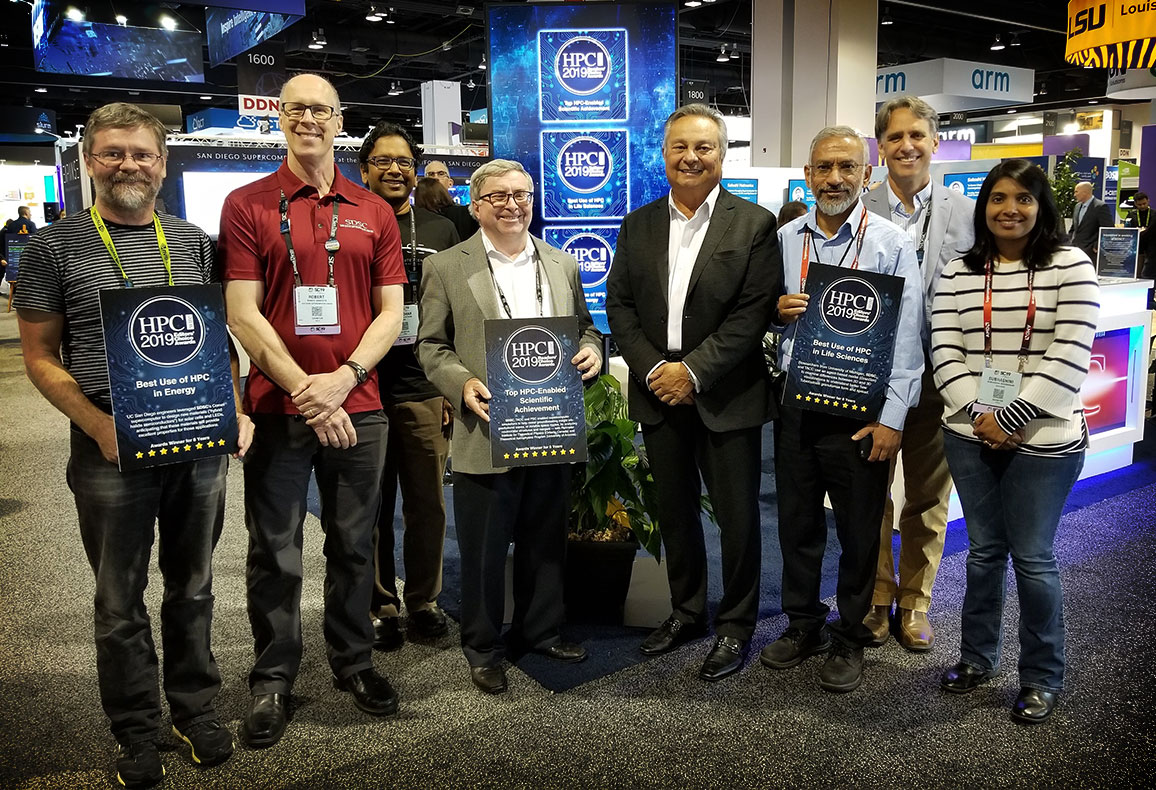

 Skip to navigation
Skip to navigation
Site Primary Navigation:
- About SDSC
- Services
- Support
- Research & Development
- Education & Training
- News & Events
Search The Site:

Published November 18, 2019

(L to R) Frank Würthwein, lead, Distributed High-Throughput Computing, SDSC; Bob Sinkovits, director, Scientific Computing Applications, SDSC; Mahidhar Tatineni, group lead, user support, SDSC; Mike Norman, director, SDSC; Tom Tabor, HPCwire publisher; Amit Majumdar, division director, Data-Enabled Scientific Computing, SDSC; Shawn Strande, deputy director, SDSC; Subhashini Sivagnanam, principal scientific computing specialist, Data-Enabled Scientific Computing division, SDSC. Credit: Cindy Wong
The San Diego Supercomputer Center (SDSC) at the University of California San Diego received three top HPCwire honors for 2019, including the online publication’s Readers’ Choice Award for the use of SDSC’s Comet supercomputer in helping astrophysics researchers gain new insights into gravitational waves, or invisible space ripples, via supercomputer simulations for analyzing neutron star structures and mergers.
HPCwire recognized SDSC along with research teams at the Perimeter Institute for Theoretical Physics in Ontario, Canada; and the Theoretical Astrophysics Program at the University of Arizona. Also supporting this landmark research project was the Pittsburgh Supercomputing Center (PSC), the Texas Advanced Computing Center (TACC), and the National Science Foundation’s Extreme Science and Engineering Discovery Environment (XSEDE) program, through which time on HPC (high-performance computing) systems is allocated to researchers.
HPCwire also recognized SDSC with the following honors for 2019:
“Every year it is our pleasure to honor the HPC community through our Readers’ and Editors’ Choice Awards, and 2019 marked an exceptional showing of industry innovation,” said Tom Tabor, CEO of Tabor Communications and publisher of HPCwire, in presenting the awards at the International Conference for High-Performance Computing, Networking, Storage, and Analysis (SC19) in Denver, CO.
“Between our worldwide readership of HPC experts and an unparalleled panel of editors, the Readers’ and Editors’ Choice Awards represent resounding recognition throughout the industry. Our congratulations goes out to all of the winners,” added Tabor.
“We’re delighted to be recognized one again as a collaborator in this year’s Top HPC-enabled Scientific Achievement as selected by HPCwire readers, as well as yet another Editors’ Choice award in the area of Life Sciences, a key element of our strategic thrust,” said SDSC Director Michael Norman. “We also appreciate the recognition given to SDSC and UC San Diego researchers for the Editors’ Choice Award in Energy-Efficient HPC Achievement for making that research possible through the use of Comet.”
SDSC, a longstanding recipient of HPCwire’s annual awards, won HPCwire’s Top HPC-enabled Supercomputing Achievement Awards in 2018 and 2016. In 2018, it was for Comet’s role in assisting an international team of scientists at the NSF-funded IceCube Neutrino Observatory in finding the first evidence of a source of high-energy cosmic neutrinos.
In 2016, SDSC was part of two Top HPC-enabled Supercomputing Achievement Awards, for the use of Comet help verify Einstein’s theory of gravitational waves. Those awards also recognized the Open Science Grid (OSG). Frank Würthwein, SDSC’s head of high-throughput computing, is the current Executive Director of the OSG, a multi-disciplinary research partnership specializing in high-throughput computational services and funded by the U.S. Department of Energy and the NSF.
About HPCwire
HPCwire is a top news and information resource covering the fastest computers in the world and the people who run them. Started in 1986, HPCwire is the news source of choice among science, technology, and business professionals interested in high-performance and data-intensive computing. More information on the HPCwire awards can be found at HPCwire.com or on Twitter through the following hashtag: #HPCwireAwards.
About SDSC
As an Organized Research Unit of UC San Diego, SDSC is considered a leader in data-intensive computing and cyberinfrastructure, providing resources, services, and expertise to the national research community, including industry and academia. SDSC supports hundreds of multidisciplinary programs spanning a wide variety of domains, from earth sciences and biology to astrophysics, bioinformatics, and health IT. SDSC’s petascale Comet supercomputer is a key resource within the National Science Foundation’s XSEDE (Extreme Science and Engineering Discovery Environment) program.
Share